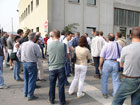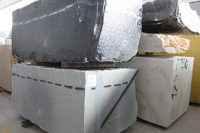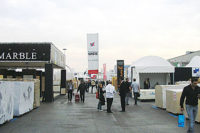
Marmomacc, the leading international stone, technology and design fair, is set to take place in Verona, Italy, from September 30 to October 3.
Marmomacc, the international exhibition of stone as well as stoneworking technology and stone design, is scheduled for September 30 to October 3 at the Veronafiere exhibition space in Verona, Italy. Once again, the trade fair will be a worldwide event, showcasing exhibitors from around the globe to an international audience. Moreover, a comprehensive cultural and educational program offers several initiatives that bridge the stone industry with the architecture and design community.
The 2008 edition of Marmomacc included 1,536 exhibitors from 54 countries, and they exhibited over a net show area of 830,000 square feet. According to show organizer, Veronafiere, last year’s event closed with more than 63,000 visitors, of which 44% came from abroad, representing more than 120 countries. As of press time, organizers also report that “enrollment applications for the 2009 edition are currently in line with 2008, a fact that demonstrates, despite the major recession in the sector, a desire to react among companies.”

The 2008 edition of Marmomacc included 1,536 exhibitors from 54 countries, and they exhibited over a net show area of 830,000 square feet - with both interior and exterior exhibit spaces.
Beyond stone materials, Marmomacc is a showcase for the world’s leading manufacturers of stoneworking equipment to release new offerings to the industry. As always, a range of new machinery models will be on display in Verona, and attendees can see them in operation first-hand. These include large-scale machines as well as smaller equipment for fabrication shops, including CNC stoneworking centers, waterjet machinery, bridge saws, polishing machines, material handling equipment and more.
Also of interest to stone-processing professionals, manufacturers of tooling and accessories such as diamond blades, polishing pads, profile wheels and more are also found in abundance.
In the area of stone installation and maintenance, leading manufacturers of adhesives, sealants, cleaners and related products will also be at Marmomacc, with a range of hands-on demonstrations to give attendees a view of the materials at work.

Aside from the exhibition, Marmomacc has developed a number of initiatives to continue strengthening the relationship between stone suppliers and the architecture and design community. Among these, the “Marmomacc Meets Design” program pairs leading companies in the stone industry with internationally-renowned architects and designers to develop projects. The program will continue this year, also including some American architects.
For several years now, Marmomacc has developed a number of initiatives to continue strengthening the relationship between stone suppliers and the architecture and design community. Among these, the “Marmomacc Meets Design” program was introduced in 2007, and enjoyed continued success last year.
During this program, leading companies in the stone industry have worked closely with internationally-renowned architects and designers to develop furnishing projects emphasizing the use of marble. The goal was that the completed custom projects would inspire smaller replications of stone furnishings that could be replicated for the general public.
The initial theme in 2007 was “The lightness of marble,” a challenge to the gravity and nature of stone. Last year, the theme of “Skin, Texture” highlighted the astonishing tactile qualities and unexpected visual aspects of stone. This year, the topic for 2009 is “Hybrid and Flexible.”
“The intention of this project is to merge materials, production processes, aesthetics, blend the mutability and metamorphosis of forms and styles and embrace the transformation of cultural and creative processes,” stated Veronafiere. “Such crossway approaches are acknowledged here as true moments in development, where design achieves a new synthesis between mechanical processes, technology, languages and attitudes.”
This edition is supported by 13 leading companies in the sector and 14 Italian and international architects and designers, including the following:
• Alberto Campo Baeza with Pibamarmi
• Aldo Cibic with Santa Margherita
• Craig Copeland and Turan Dada with Henraux
• Michele De Lucchi with MGM Furnari
• Marco Fagioli and Emanuel Gargano with Vaselli Marmi
• James Irvine with Marsotto
• Marta Laudani and Marco Romanelli with F.lli Mele
• Francesco Lucchese with Scalvini Marmi
• Marco Piva with Lasa Marmo
• Luca Scacchetti with Grassi Pietre
• Tobia Scarpa with Fratelli Testi
• Francesco Steccanella with Il Casone
• Patricia Urquiola with Budri
Also introduced in 2007, the “Best Communicator Award” is another collaboration between stone suppliers and designers with the goal of “stimulating awareness of the value of their stands in relation to brand image and overall exhibition impact.”

The “Best Communicator Award” is another collaboration between stone suppliers and designers with the goal of “stimulating awareness of the value of their stands in relation to brand image and overall exhibition impact.” Winners last year included Umberto Franchi.
A range of other educational initiatives are also slated as part of Marmomacc. “Sustaining Stone, Sustainable Stone” - a study in collaboration with the National Institute of Urbanistics and the Order of Architects, Planners, Landscapers and Conservationists of Verona - will take place on October 2 in the Puccini Room in the Arena Congress Center.
“Growing numbers of studies and research projects into power consumption and the sustainable environment- particular in highly populated urban areas - has brought to the fore the responsibilities of architecture [to respect] the environmental equilibrium of the planet,” stated organizers. “Different architectural languages and construction systems in using stone - from thin cladding to massive and structural use - make it possible to measure the degree of power efficiency of the material in relation to the site, climate, resources, economy and comfort standard. Countries such as the U.S. have finalized LEED certification systems that effectively encourage construction practices based on principles of sustainability - concerning sites, water efficiency, energy saving, design innovation, etc. - and indicate the most sustainable materials to be used. Stone, as a construction material, has natural characteristics that may potentially ensure that buildings boast excellent capacities with regard to the sustainable environment, and it is about to join this certification system. Marmomacc intends to organize a ‘study convention’ discussing these themes - involving architects, urban planners and technicians specializing in this design approach - together with researchers and producers of stone materials aware of the problem. [The goal is] to promote a positive and correct process of approach to stone materials and their use in architecture and landscaping.”
In another program, Marmomacc and the Faculty of Architecture at Pescara University are collaborating on a technical-scientific seminar on the use of stone materials. “The seminar we organized in 2008 achieved considerable feedback,” said Professor Domenico Potenza, who conceived and organized the initiative together with colleague Francesco Grisante. “And so we replicated the concept this year.”
This experience was set up in 2008 and immediately became a permanent initiative that will be replicated again for the next academic year.
Last year, all the courses in question involved a specific theme: analysis, development and design of a single-family home: “This year, the focus is no longer on a single home,” Potenza said. “So projects now also range towards more important structures, such as a school or the square of a university campus. The seminar this year again involves around 40 students at various levels.
“In order to explain the education experience: the catalog will be presented at this year’s edition of the event and also contains two extemporary experiences associated with the seminar itself,” Potenza continued. “One [element] is attendance by students at an international workshop dealing with stone materials held in Verona - organized by Christian Pongratz and Vincenzo Pavan. The other focuses on the development of new educational workshops at the Pescara Faculty of Architecture, based on a project by Professor Ludovico Micara and precisely involving a stone envelope. Lastly, the publication also presents a report by Mauro Albano, Marmomacc brand manager, and an interesting note by the curators of the exhibition, Natalia Risola and Tiziana Latorre.”
The situation in Italy
Earlier this summer, show organizers gave a synopsis of Italy’s stone industry at a promotional tour in Milan. According to their figures, Italy alone boasts about 60,000 workers in the stone industry, including 11,000 companies (between industrial plants and small business), worth 3 billion euros (U.S. $4.3 billion).
The data indicates that the market actually held up well in 2008, but projects to a significant downturn in 2009. Data processed by Confindustria Marmomacchine in fact indicate that exports of machinery at the end of 2008 came to 826 million euros (U.S. $1.182 billion) against 851 euros (U.S. $1.218 billion) in 2007.
With regards to marble, granite and other decorative stones, exports in 2008 posted a decline of 5.3% in volume (2.7 million tons of processed material compared to 2.9 million in 2007). In terms of value, exports of stone dropped about 6.9% - dipping to 1.480 billion euros (U.S. $2.218 billion) in 2008 as compared to 1.580 billion (U.S. $2.261 billion) the previous year.
“The world situation is complex, and the natural stone field is no exception,” said Giovanni Mantovani, Director General of Veronafiere. “Sales are down, as well as imports of material, which means lower product processing quantities for our districts. Forecasts for 2009 are by no means rosy, although a few timid signs of a recovery are coming from across the Atlantic. We hope, however, that the event will be able to ensure a little more trust in the value chain and with this a desire to get going again. In this regard, Veronafiere is already operating to provide effective responses to all the needs of companies in close agreement with production districts.”
“The signal coming from companies is to tackle the crisis by seeking new markets and new commercial outlets,” said Claudio Valente, Deputy President of Veronafiere. “Our task is to work at the side of companies to help them identify precisely such more dynamic markets to encourage growth opportunities, not the least through the cultural events, experiments and training for architects that Marmomacc proposes every year.”

The 11th edition of “Designing with Natural Stone” course for architects will run from September 28 - October 2, 2009 in Verona, Italy, in conjunction with Marmomacc. The program is a unique combination of classroom lectures, guided architectural tours and field trips to nearby quarries as well as to natural stone processing facilities.
Sidebar: Marmomacc 2009 to Feature 11th Edition of Veronafiere's AIA-Approved Continuing Education Course “Designing with Natural Stoneâ€
The 11th edition of “Designing with Natural Stone” will run from September 28 - October 2, 2009 in Verona, Italy, in conjunction with Marmomacc, the leading trade show for stone and design. The class is limited to 30 architects, including 16 from the U.S., and the others from Canada, the U.K., South Africa, India and Australia.Veronafiere offers the course to help architects learn advanced techniques in the use of marble, granite and other stone materials. The program is a unique combination of classroom lectures, guided architectural tours and field trips to nearby quarries as well as to natural stone-processing facilities. This comprehensive approach enables architects to better understand the full cycle, including how marble is quarried, cut, processed, finished, selected for specific jobs and installed, using the latest technologies and products.
The 2009 edition will include visits to a Breccia Pernice quarry and Palladian architectural works in Vicenza, as well as an architectural tour of Verona. Another highlight will be a visit of stone companies in the Valle del Chiampo area, hosted by the Consorzio Marmisti Chiampo. In addition, the course provides time to explore Marmomacc, with its more than 1,500 exhibitors of stone and stone-related products from around the world.

By taking architects directly to the sources where stone is quarried and fabricated, instructors illustrate the “full cycle” of stone processing - using the latest technologies and products.
• “I was really grateful to be included in the course. Even though I started out with a certain amount of knowledge about stone, I felt like I learned a lot and was exposed to things I would not otherwise have been exposed to.”
- Debra Gerod, Gruen Associates, Los Angeles, CA
• “I found so much of the course to be useful. I am constantly thinking of new ways to apply what I learned.”
- Stephen Alexander, Prince Alexander Partners, Indianapolis, IN
• “I feel honored that I was chosen to go and will value the experience the rest of my life. It is one of the highlights of my career”
- Ken Harry, Ken R. Harry Associates, Houston, TX
Over 160 AIA architects from all over the U.S. have participated in previous editions of the course. Participants earn about 20 AIA/CES learning-unit hours.
Veronafiere is recognized as an official continuing education provider by the AIA (American Institute of Architects), the association whose members include most U.S. architects (more than 85,000). Each year, scholarships are awarded to about 15 U.S. architects to allow them to participate in the program. Architects compete for grants that cover tuition, meals, hotel accommodations and local transportation. The course is also recognized by RIBA (Royal Institute of British Architects) and the RAIC (Royal Architectural Institute of Canada).

